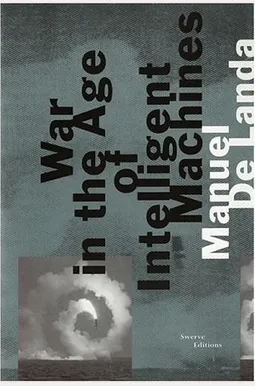
Manuel De Landa and Computerized War
A year after Desert Storm, what images still grip the mind? The weeping jarhead, the Fourth of July over Baghdad, the charred traffic jam of retreat? For me, it is the blurry black-and-white roller-coaster ride the “smart bomb’“ took us on as it dived into the roof of its target. Not only did the clip merge the bomb’s p.o.v. with our own (a connection broken at the exact moment of real contact), but it communicated the creepy sense that the death machine knew exactly what it was doing. In that glimmer of technological sentience, Manuel De Landa would say, we glimpsed the next stage of military evolution: the predatory machine.
Half military history, half poststructuralist pop science, De Landa’s remarkable War in the Age of Intelligent Machines reveals the secret link between Michel Foucault and the Terminator. To boot up his text, De Landa imagines a robot historian investigating the evolution of its own kind, a scholar for whom humans would be merely “industrious insects pollinating an independent species of machine-flowers that simply did not possess its own reproductive organs.” Professor Robot would track its ancestors as they emerged from the Darwinian pressures created by competing military institutions, “war machines” composed not only of technologies, but of different “machinic paradigms” which organize men, weapons, information, and materials.
De Landa, of course, becomes the robot. Cruising through scattered fields of metallurgy and management, computer science and chaos theory, De Landa tracks different components of the war machine as it evolves in power and complexity. But what exactly is evolving? Cribbing a phrase from Gilles Deleuze, De Landa calls it the “machinic phylum,” which he describes as “the overall set of self-organizing processes in the universe.” Examples of this nonorganic “life” are molecules that suddenly cooperate into chemical clocks or bullets that achieve stability after reaching a certain rate of spin. These natural threshold points are “channeled” by humans into military technology, first by hands-on artisans following rules of thumb, and then by the instrumental rationality of industrial production. But even in the hands of control-freak military industrial capitalists, the machine phylum keeps proliferating.
While the data De Landa digs up would thrill any cyberpunk or technoculture maven, it’s the tripped-out method behind the scenes that almost steals the show. De Landa’s one of those guys who sees everything as part of larger patterns, and the more you read the book the more the patterns begin to play across your brain. Unfortunately, his leaps, links, and digressions sometimes resemble the chaos he’s fond of invoking, and for all the book’s careful research, De Landa’s writing and organization are about as elegant as an instruction manual. Still, without lapsing into rants or speculative flights, De Landa brings to his material the furious eclecticism and infectious zeal that only an autodidact can generate, and for good reason: he’s an outsider intellectual, earning his keep doing computer graphics work for advertising and feeding his mind with whatever it wants. There should be more like him.
De Landa’s ability to synthesize widely different theoretical models without lapsing into jargon or levitating into space is particularly impressive. He makes excellent use of chaos theory, that trendy but revolutionary branch of mathematics which uncovers the deep statistical similarities among all sorts of natural processes of self-organization, from cyclones to trailing cigarette smoke to dripping faucets. On the surface, turbulent streams and Napolean’s army hardly seem like birds of a feather, but De Landa shows how once you start looking at things as dynamic systems, analogies stick. Conventional military figures like “great inventors” and “military geniuses” are trees that obstruct the view of a greater forest, a forest that emerges from gurgling chaos.
At the same time that De Landa emphasizes the turbulence of military history, he highlights the central role that information plays in the war machine. From tactics to spying to secret codes to war games, the military has always dealt with intense modes of information; and it’s no accident that what many consider the first computer—Alan Turing’s Colossus—was designed to crack codes during World War II. De Landa also shows how the military nursed the computer industry to life—particularly the artificial-intelligence research that will one day enable machines to hunt people down independent of human control.
For De Landa, the military is like an ant colony with guns, its weapons increasingly autonomous and its “great men” at best catalysts for larger evolutions of power. The military creates a literal no-man’s zone, and it’s not surprising that behind De Landa’s fractals and conoidal bullets lurks Foucault and Deleuze, both of whom try to philosophize outside the human subject. But rather than obscuring their theories in jargon the way most French-fried navel-gazing academics do, De Landa reads them like pop science, with Foucault becoming the master of management and organization and Deleuze the prophet of chaos consciousness. Coupled with his robot history and scientific understanding, De Landa’s poststructuralism is quite persuasive, though it does not bode well for those human subjects seeking to shut down the military-industrial complex. As he puts it, his book was designed in part “to show the futility of any attempt to dismantle the war machine through violence (or levity).” The tactics De Landa suggests for keeping humans in the loop—man-machine interfaces, massively parallel programming, intelligent networks—only underline the cyberpunk core of this argument: that in order to wrest freedom from the machines, we must (and will) follow their lead.
See also: De Landa Destratified




